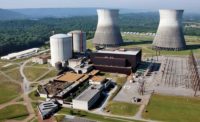
The Tennessee Valley Authority was set to begin pouring the concrete foundation in late August for a 12,000-sq-ft reactor containment structure at its Brown's Ferry nuclear powerplant in Alabama that is being designed to withstand a 10,000-year earthquake and 300-mph winds. Specifications for the building, known as FLEX, were developed by the U.S. Nuclear Regulatory Commission from lessons learned after the 2011 Fukushima accident in Japan.
"It's an entirely new layer of protection to be used for a beyond-design flood, earthquake or tornado," says a TVA spokesman. Robert Feiel, project engineer for Knoxville-based Mesa Associates, says the structure's design addresses the loss of power that crippled reactor cooling systems at Fukushima. NRC is requiring the upgrades for the new Unit 2 at TVA's Watt's Bar plant, also in Tennessee, to obtain an operating license. It is set to start up commercially by the end of 2015, says TVA.
Mesa designed the FLEX buildings at the two sites and also at TVA's Sequoyah plant in Tennessee. Kiewit is contractor for the Watt's Bar and Brown's Ferry structures. The Watt's Bar building must withstand wind speeds up to 360 mph and the assault of "tornado missiles," including a 4,000-lb vehicle traveling at 230 ft per second, says Travis Smith, Mesa lead structural engineer. "The intent is to take the impact and not be perforated," he says. Walls are 18-in.-thick reinforced concrete, and the roof is 16 in. of solid concrete on a 3-in. metal deck. According to Neil Gannon, leader of TVA's Fukushima enhancement projects, the upgrades will cost up to $266 million.




Post a comment to this article
Report Abusive Comment